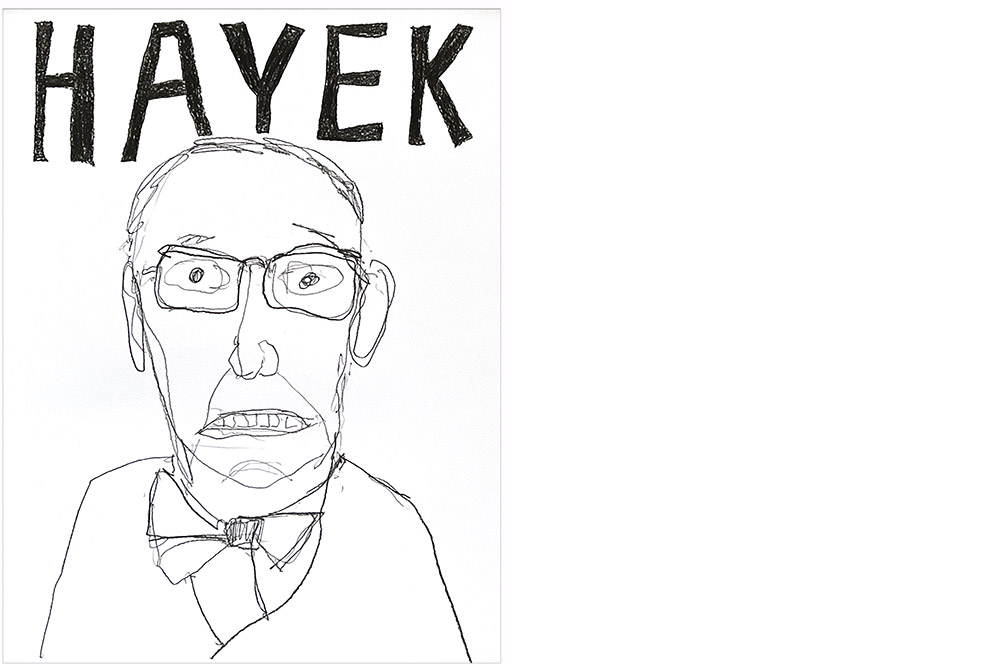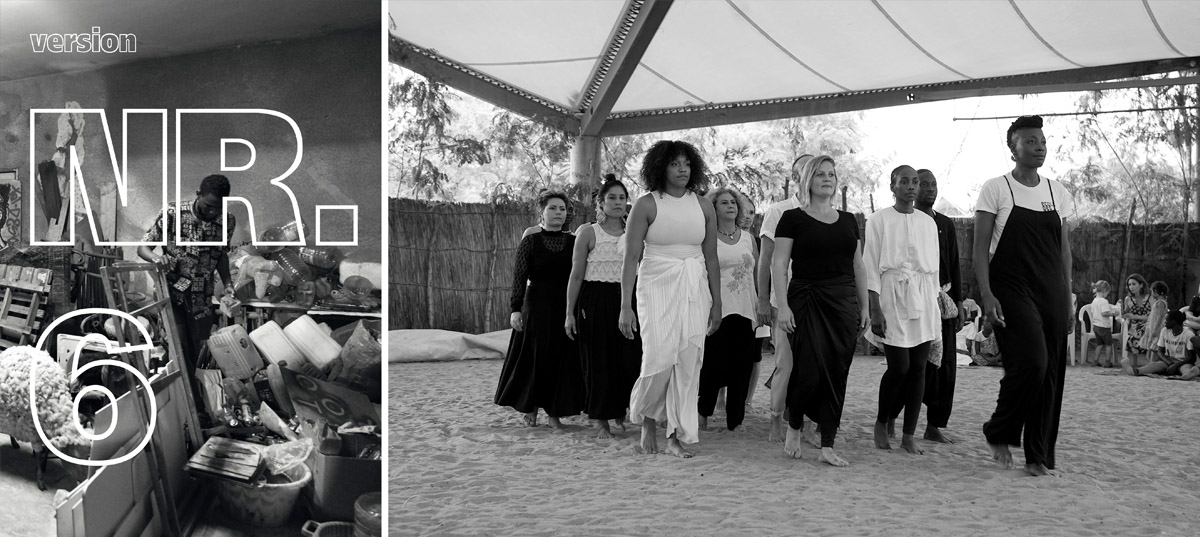
"Der Neoliberalismus kommt aus Wien"
Eröffnung: Donnerstag, 15. Mai, 19 Uhr / Begrüßung: Sira-Zoé Schmid, Bildrecht / Zum Werk: Tina Teufel, Museum der Moderne Salzburg / Bildraum 01 | Strauchgasse 2, 1010 Wien Di-Fr: 13-18 Uhr
Manfred Grübl untersucht in seiner Ausstellung im Bildraum 01 wie sich wirtschaftliche Strukturen und Machtverhältnisse auf die Freiheit von Individuum und Gesellschaft auswirken. In seiner multimedialen Assemblage entwirft der Künstler ein systemkritisches Tableau kapitalistischer Symbolik. Mit dem Ausstellungs- und gleichzeitigen Werktitel "Der Neoliberalismus kommt aus Wien" verweist Grübl auf den erheblichen Einfluss österreichischer Wirtschaftstheoretiker Ludwig Heinrich von Mises und Friedrich August von Hayek auf unser heutiges Wirtschaftssystem. In der im Zentrum der Ausstellung stehenden, gleichnamigen Arbeit seziert er akribisch die kapitalistischen Machtverhältnisse in einem sechs Meter langen Fries und nimmt uns auf eine Zeitreise durch die Entstehungsgeschichte der wichtigsten Parameter & Symbole des Neoliberalismus. Manfred Grübls Werk geprägt von einem multimedialen Schaffensprozess, verbindet gekonnt unterschiedliche Medien wie Fotografie, Video, Performance und Zeichnung. Seinen Werken liegt meist eine politische und systemkritische Haltung zugrunde. Wie auch hier im Bildraum 01. Die Ausstellung gleicht einer Art Abrechnung mit den führenden Mächten und deren Unterdrückungs-/Kontroll-Instrumenten. Er stellt sie in "Die Politik hat nichts zu sagen" bloß, entlarvt sie in "The Power of Clothing" entwaffnet sie in decision maker und stellt einen neuen/alten Ansatz in "Arbeit Geld Natur" vor.

Massagematten
Installation Bürogebäude Proges, Linz
Im Foyerbereich eines Bürogebäudes werden Massagematten installiert. Sie sind gedacht als Entspannungs- und Erholungsnischen - man kann sich massieren lassen und die Zeit für Telefonate und Internet Research nutzen. Die/der Anwender*innen sind Teil der künstlerische Arbeit.

"draw the audience", neue Edition
Zeichnungen auf Papier und unterschiedlichen Materialien
Drawings from the audience sind Zeichnungen, die durch Beobachtungen von Ausstellungsbesucher*innen entstanden. Material und Linienführung stehen in Dialog mit der jeweiligen Person.

VERSION 6 magazine presentation
KENU, LE PALACE INFORMEL, PARTCOURS12 / 8 December at 7 pm / cité africa n°1, Ouakam, 12300 Dakar / DJ ACT IBAAKU
VERSION est un magazine autrichien consacré à la production artistique et culturelle contemporaine, qui traite des questions liées aux approches et aux conditions des stratégies artistiques. Le numéro actuel VERSION 6 présente un aperçu de la scène artistique actuelle à Dakar. Yasmine Eid-Sabbagh parle de son expérience en tant qu'artiste à la documenta 15 et de sa pratique de lier l'art et la vie quotidienne à Dakar. Alibeta Sarr et Ibaaku présentent leur espace artistique KENU, organisé de manière collective. Nous avons eu l'occasion de nous entretenir avec Alesandra Seutin au sujet de l'Ècole des Sables, un centre de danse africaine traditionnelle et contemporaine. La Raw Material Company, l'une des plus importantes institutions culturelles contemporaines, est présentée par Fatima Bintou Rassoul Sy, Delphine Buysse et Ibrahima Thiam. En outre, nous avons pu publier un entretien de Zain Raza avec Noam Chomsky sur la guerre en Ukraine. Le groupe Kriegsbilder évoque les spécificités de la création cinématographique ukrainienne et la situation de l'industrie cinématographique en Ukraine. Hans Schabus et Isa Rosenberger se sont entretenus avec nous de leurs travaux et de leur approche artistique respective. Les inserts proviennent de l'artiste ukrainien Mark Chehodaiev, de l'artiste chilienne Patrizia Domínguez et du département d'art spécifique au lieu de l'Université des arts appliqués de Vienne.

Public Matters / Contemporary Art in the Belvedere Garden / 13 May 2023 - 1 October 2023 / Manfred Grübl, Anna Jermolaewa
"HALBMAST" / "Jede*r hat das Recht auf Leben, Freiheit und Sicherheit der Person" ist der Allgemeinen Erklärung der Menschenrechte von 1948 entnommen und dieser Satz umfaßt die Weltkugel auf der Flagge. Grundrechte sind ein verfassungsgesetzlich gewährleistetes Recht. Die Menschenrechtskonvention ist in der Regel auch in die Verfassung mit eingeschrieben. Für die Fahne und unser Projekt haben wir bewusst dieses fundamentale Grundrecht gewählt, weil es jedem Menschen zusteht. Das Recht auf Leben ist die Vorbedingung für die Ausübung aller anderen Menschenrechte und daher eine zentrale Garantie, unabhängig von der Herkunft. Die Flagge im Belvedere 21 ist ein weitreichendes Signal und fordert die Wahrung der Grundrechte, ohne die unsere demokratischen Werte ohne Fundament sind.
Art – a public matter? Ever since their opening to the general public in the 1780s, the Belvedere Gardens have been used extensively as places for recreation and communality. The occasion of the 300th anniversary of the completion of the Upper Belvedere is a good opportunity to emphasize that they are clearly also places of art. From May through September, an extensive contemporary sculpture project complements the Baroque sculpture program at the Belvedere’s three locations. Site-specific as well as existing works by international and local artists will connect all of the museum’s gardens along a path – from the main courtyard of the Lower Belvedere and its Privy Garden to the grand Baroque gardens of the Upper Belvedere and the modernist sculpture garden of the Belvedere 21 – highlighting how the gardens organically grew into an ensemble. Public Matters follows an expanded concept of sculpture that includes time- and process-oriented approaches. As a critical homage, the show addresses the representation of power in the past and present as well as its transformation over time. In particular, the focus is on aspects of the public and the public sphere that emerge with and through art. The project is accompanied by a comprehensive publication featuring essays and texts on the works on display. With works by Thomas Baumann, Renate Bertlmann, Louise Bourgeois, Verena Dengler, Carola Dertnig, VALIE EXPORT, Wil Frenken und Fria Elfen, Thomas Geiger, Roland Goeschl, Dan Graham, Thomas Houseago, Alfred Hrdlicka, Iman Issa, Anna Jermolaewa und Manfred Grübl, Kapwani Kiwanga, Brigitte Kowanz, Hans Kupelwieser, Marko Lulić, Goshka Macuga, Hans Op de Beeck, Ingeborg G. Pluhar, Maruša Sagadin, Toni Schmale, Kateřina Šedá, Socratis Socratous, Kara Walker, Lawrence Weiner, Lois Weinberger, Franz West, Fritz Wotruba, Heimo Zobernig Curators: Christiane Erharter, Georg Lechner, Sergey Harutoonian, Axel Köhne, Claudia Slanar, Luisa Ziaja Assistant curators: Miroslav Halak, Andrea Kopranovic